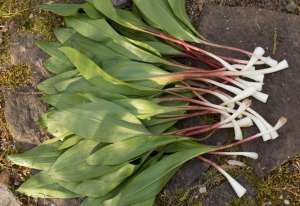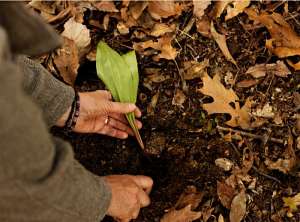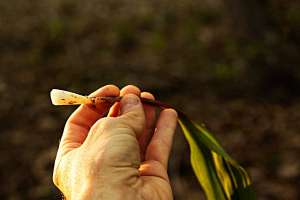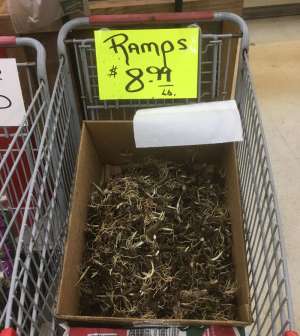- Where to find ramps
- Sustainability
- How to harvest ramps
- Where to buy ramps
- How to store ramps
- How to cook ramps
- Ramps and Watercress recipe
- Ramp compound butter recipe
Ramps, ramsons or wild leeks, are one of the earliest wild edibles to emerge, and, for some, they're the holy grail of wild edibles.
What are ramps?
They're really a type of wild onion with a unique garlicky-onion flavor, which some people find overwhelming. Most folks either love them or despise them.
Some internet sources say they look like scallions, but they look nothing like scallions.
Ramp leaves are flat and much broader than their bulbs, whereas scallion leaves are hollow and narrow -- about the same width as their bulbs.
Why are they so popular?
For one, their distinct pungent flavor can't be rivaled by anything that is commercially cultivated.
Secondly, they're only available for a very short window in the spring.
Historically ramps were considered a spring tonic in the Appalachians.
Early settlers looked forward to harvesting them after long, hungry winters, as it would have been one of the first vegetables they had eaten in months.

Sustainably harvested ramps.
Where to find
Ramps occur in Eastern North America from Georgia to Canada. They're easily recognized by their 1, 2, or 3 broad leaves measuring 1 to 3 1/2 inches wide and 4 to 12 inches long.
There are a couple of varieties:
Allium tricoccum var. tricoccum: These have wider leaves and red stems.
Allium tricoccum var. burdickii: Also known as narrow-leaf or white ramps.
White-stemmed narrow-leaf ramps (Allium tricoccum var. burdickii) tend to have a milder flavor than the red-stemmed variety. They also have smaller leaves (up to 1 1/2 inches wide), as well as smaller bulbs.
Ramp leaves appear from March to April and last until around mid-May to June depending on the local climate. As temperatures get warmer, the leaves will turn yellow and die.
Look for them underneath dense deciduous forest canopy in soil that's rich with organic matter.
In general, Narrow-leaf ramps are more likely to be found in more well-drained, dryer woods, while red-stemmed ramps prefer damper soil.
That being said, it's not uncommon to find both varieties growing side-by-side.
There are some dangerous look-alikes so be sure the plants you pick smell like onion or garlic.
Do not pick the dangerous Lily of the Valley (Convallaria majalis) or False hellebore (Veratrum genus) by mistake.
Again, make sure they smell like onion or garlic. If you're unsure, let a knowledgeable forager confirm your find or just pass on picking.
It may also be helpful to consult multiple references for more positive identification.
Sustainability
Unfortunately for ramps, they're super-trendy these days. Chefs, foodies, and other ramp-lovers flock to the mountains by the thousands for a chance to bask in their gourmet-ness.
"Ramp feeds," known as ramp festivals now, have been taking a toll on ramp populations for years and the added pressure of their recent popularity has really put a hurting on their numbers.
The implications affect conservationists and foodies alike. Cindy and I are conservationists first and foragers second. What this means for us is that ramping is not only unsustainable, but it gets more arduous each year as we climb higher and longer to find undiscovered ramp patches.
Traditionally, the Cherokee dug, and still dig, ramps by leaving the roots. This is done by cutting off the bottom of the bulb with a knife while it's still in the ground (more on the how-to below).

How to harvest
If you plan on digging ramps on public land, you'll want to look into whether local regulations restrict harvest amounts, where harvesting is permitted, etc.
In West Virginia where we live, as of 2020, the Forest Service allows harvesting for personal use only -- anyone can dig up to two gallons of ramps at a time. That's about the volume of a plastic grocery bag or, according to the USFS, about 180 plants with leaves and roots.
And digging is no longer permitted in some parks due to declining ramp populations, so please be aware of local rules and conservation issues.
Here are a few things you'll need for harvesting ramps:
-
Time
This one is really important. It's way too easy to run up to the ramp patch after work with good intentions of sustainbly digging ramps. You get to the trailhead at 5:30pm and it's 6pm by the time you're digging ramps. The sun's about to slip behind the mountains and you're in a sudden hurry to get your ramps and get out of there. So you abandon your plan and jerk as many roots out of the ground as you can before running out. DON'T DO IT!Sustainably harvesting takes more time, so you really need to make allowance for it. Plus it's a lot more fun to have a leisurely walk into the woods, not worrying about racing the waning light. If you can't give yourself the time to do it, please consider taking only greens and leaving the bulbs undisturbed. You won't need nearly as much time if you only harvest leaves!
-
Sharp hunting knife
Make sure it's sharp! A dull knife will do more harm than good -- you'll end up mutilating the bulb so it's not useable as food and not viable as a plant. You may even want to touch up the blade as you dig, since the grit of the dirt will take your edge. You'll also want to make sure the blade is at least three or four inches so you can easily reach the root without disturbing the soil.If you insist on digging the root, use a hori hori knife to minimize impact.
-
Backpack or shoulder bag
I usually put a few plastic grocery bags in a backpack and then load a bag or two with ramps before putting them in my pack, which helps keeps the dirt out of the pack.
The most sustainable way to harvest ramps is to cut only one leaf, leaving the bulb and second leaf to continue growing. This is least impactful on the soil, the plant, and the colony as a whole.
The leaves, in my opinion are the best part, anyway, and taking only leaves is the best way to ensure the colony will remain viable.

If you insist on taking bulbs, please dig sustainably with a knife: Simply insert your knife into the dirt at an angle and slice off a third or so of the root, leaving it in the ground to re-grow. Then pull the rest of the plant out by its stems.
It will take a little practice to get a feel for where to put the knife. You can also gently pull back the dirt from around the bulb so you can see where you're cutting. If you do this, make sure to pull back just enough dirt to expose a little bit of the bulb and re-cover the roots after cutting.
That's all there is to digging. Please be judicious and don't take any more than you will use.
I find that when I overzealously harvest, it makes more work for me in the long run, because some ramps will inevitably go bad before I can get to them. There's not much more disgusting than the smell of past-their-prime ramps. And a few ramps go a long way so there's no need to stockpile them.
Even though we practice sustainable harvest, I'm afraid the ever-inceasing demand will eclipse the slow procreation.
According to North Carolina Extension Horticultural Specialist Jeanine M. Davis, ramps can be transplanted and cultivated from seed in climates where ramps don't normally grow. Apparently, it takes some effort to germinate seeds when climes are warmer than ideal, but it can be done.
And once a good patch is established, it requires little maintenance. Jeanine recommends the book Having Your Ramps and Eating Them Too by the "Johnny Appleseed of Ramps" for more info on cultivating ramps. Unfortunately this book is no longer in print.
We've been growing our own for a while. Our homestead is located in the ramp belt now, but our previous place was outside of ramp habitat. When we lived there, our planted ramps didn't spread because conditions weren't ideal.
They did grow, though, and as long as we continued to plant new ramps, we always had a steady supply right outside of our door.
Where to buy
If you're lucky enough to live in an area where ramps are abundant, it's not uncommon to see them in the grocery store when they're in season. Where we live, they're also common in seasonal dishes served at local restaurants.

How to store
Ramps are only in season for a month or so, but, for us, getting them is only half the problem. I usually come back from a good ramping trip with enough for us to eat fresh before they go bad with a little extra to keep for eating later (I rarely go digging more than once a season unless I come home with a particularly light harvest).
Both leaves and bulbs can be eaten and both are delicious. They're best used fresh, but both can be put away for eating later in the year.
The easiest way to store ramp bulbs is by freezing: Simply cut off the greens, clean the dirt off the bulbs and cut off the roots (if your ramps still have roots). Then spread the bulbs out on a sheet pan or waxed paper so they are not touching and freeze. This prevents them from sticking together.
Once they're frozen, put them in jars or plastic containers, seal tightly and put in the freezer for up to six months. You can also wrap them individually in wax paper and store frozen in sealed jars. They can also be pickled but we don't usually bother.
The greens won't last long fresh and deteriorate when frozen. They can be dried, but they lose a lot of their flavor. We've found the best way to preserve them is by making ramp compound butter (see recipe below). A close second is ramp pesto. Either can be stored in the refrigerator in the short term or frozen for use later.
For short term storage put ramps in the refrigerator as soon as possible. They should be stored uncleaned. If a refrigerator is not immediately available ramps can be kept with the bulbs submerged in a bucket of water and placed in a cool shaded area.
The leaves will start to wilt in the refrigerator after 4 days or so and in the bucket after a day or so depending on temperature.
How to cook
Ramp bulbs and leaves can be diced and used just as you would use onions, green onions, leeks, chives and garlic, but they are much more potent. They pair well with the following:
-
pasta
-
eggs
-
chanterelle mushrooms and other wild mushrooms
-
potatoes
-
stir fried and raw greens
-
pork
Some folks like to eat ramps raw. I like a little chopped up in a salad, but ramps as a cooked vegetable are a lot more fun. My favorite way to eat them is mixed into venison burgers or in ramp and white cheddar soup. And it's hard to beat ramps and eggs for breakfast.
 A few years back, Cindy came across this sweet little book from West Virginia called Mom & Ramps Forever! by Barbara Beury McCallum. There's some fun anecdotal history on ramps in there. It's also a collection of old timey recipes and stand-bys like pickled ramps and ramp champ - mashed potatoes with ramps. Here's one of the recipes... quick and easy and sounds tasty:
A few years back, Cindy came across this sweet little book from West Virginia called Mom & Ramps Forever! by Barbara Beury McCallum. There's some fun anecdotal history on ramps in there. It's also a collection of old timey recipes and stand-bys like pickled ramps and ramp champ - mashed potatoes with ramps. Here's one of the recipes... quick and easy and sounds tasty:
Ramps With Watercress
"Fry some bacon until crisp, remove the bacon then drain off part of the bacon drippings. Put washed cress into the pan with the water that clings to it. Cook covered, until tender. Garnish with crumpled bacon, finely chopped ramps, and some chopped hard cooked eggs."
Unfortunately, Mom & Ramps Forever! is out of print, but it's a nice one for the collection if you can find it.
Ramp Compound Butter
1 lb. softened butter
1 to 2 cups ramp greens, chopped
2 Tbls freshly squeezed lemon juice
Combine all ingredients in a food processor until smooth and pack in small containers.
Use just as you would garlic butter.
Comments
We have tried to cultivate ramps from seed for 3 years here in Connecticut with no success. Only by moving early spring bulbs with lots of little roots still attached have we managed to transplant a few plants. We would love to become a Johnny Rampseed of the Northeast otherwise!
Dig a patch dirt and root at least 4" deep. Replant with all the native dirt.
We find that by finely slicing the leaves into thin ribbons and packing them into plastic containers, they freeze extremely well. Then we just add them still frozen to soups, biscuits, and other recipes. That way we are able to use ramps all year.
How sad to read that over harvesting is decimating your local ramp population :-(
- over here in London, the ancient forest on the outskirts has banned the gathering of wild mushrooms for the same reason. I (respectfully) have two suggestions for you, if germination at lower altitudes seems too hit and miss. 1) Go back to the mountains when the ramp season is over and the seeds have properly ripened, and distribute them in places that you know used to have colonies - as they grow in clumps, some seed never makes it to the forest floor, so as long as you harvest responsibly - say taking only 1/8 of seeds from a clump, you can help reverse the damage done by others.
2) For growing in your own urban space, try the seeds of a related species - in Europe, Allium ursinum grows wild, we call it Wild Garlic or Ransoms. The bulbs are smaller than your Ramps, but the leaves are about the same size and delish, and they grow at sea level. Check out the Plants for a Future website, pfaf.org, which lists over 7000 useful plants from around the world, to see pictures. If you enter 'Allium' in their search engine, both your Ramps, and our Ransoms are listed on the 3rd page. I have a thriving colony in a shady spot in my garden. Love and blessings.
It is illegal to collect "ramps" any more in Québec due to over-harvesting - they were so sought after by the restaurant industry and exports too...they take three years to germinate from seed, I heard, and several more to become mature enough to flower and produce seed. A bit like how Ginseng and Goldenseal were wiped out from commercialization. If we could only take as much as we need, gently, and help the next generation propagate, as it should be done, these helpful plants would be there for us for eternity.
I'm from central Ohio and had an old timer show me where ramps were located along an old railroad bed. I dug up a bunch and replanted in my woods at home - north side of the hill. Nothing special, just stuck them in the ground. They began producing the next year, but I left them go for several years before harvesting. It has been 10 years now, and I have 4 patches that are going nuts! The largest is 10 ft x 10 ft with satellite patches beginning around them. I tried planting 2 separate patches at anearby location on the South side of the same hill, with limited success.
HI! Wonderful to hear from fellow rampy folks! I'm in SE Ohio, transplanted a few bulbs 4 years ago, then more 2 years ago: NE slope with Sugar Maples, Poplars, other indicator species. The transplants did pretty well, I enjoyed sitting out talking with them and munching one leaf from a few of them this spring.
I also planted seed in the same vicinity 2 years ago but none have made their appearance yet. One just never knows when they may pop up, similar to wildflower seed...might take a number of years and then all of a sudden I get a surprise.
Thanks for caring :-) and best wishes!
Just wanted to say, that we sustainably harvest a small amount of them, maybe 5 dozen, and I leave the dirt on them until were ready to use them, seems to make them last a bit longer. I also took home a few, maybe 10 with roots intact, and planted them in my garden, they are doing quite well. It doesn't look like anyone else knows about the patch we found, it's quite a large area.
For what it is worth, growing wild leeks from seed is about a seven year process although as someone posted above that it can happen in less. I transplanted bulbs to an ideal location in my yard about 5 years ago but have yet to see them propagate. I have a place in the wild where I have been very selective about digging, taking only a few bulbs for pickling each year. I generally cut the leaves off for drying and use them year around in egg omelets, meat seasoning, sour cream dip etc. Leaving the root portion of the bulb as stated by the author is a great idea to insure future generations the opportunity to enjoy leeks.
Most of my family came from northwestern Pennsylvania and foraging for leeks has been a spring ritual for many years. Spring trout season is also leek season and my grandparents depended on those fresh greens during the Great Depression. For those that don't like the strong garlicky onion after affects cooking the leeks mitigates a lot of that lingering odor.
I grew up in West Virginia eating ramps all my life. I now live in southern Indiana and am working on turning my rural county into a ramp capitol. I am amazed to understand how ramps can get overharvested. If everyone knew that all one needs to do is go to your favorite ramp patch in late September and discover the hundreds of seed pods (like garlic) sticking up 10-12" from the forest floor. Scoop them up (little black beebees) and scatter them somewhere else before the leaves fall off the trees in order to bed them in. I have started hundreds of ramp patches this way all over the county, especially on public lands, state and national park grounds.